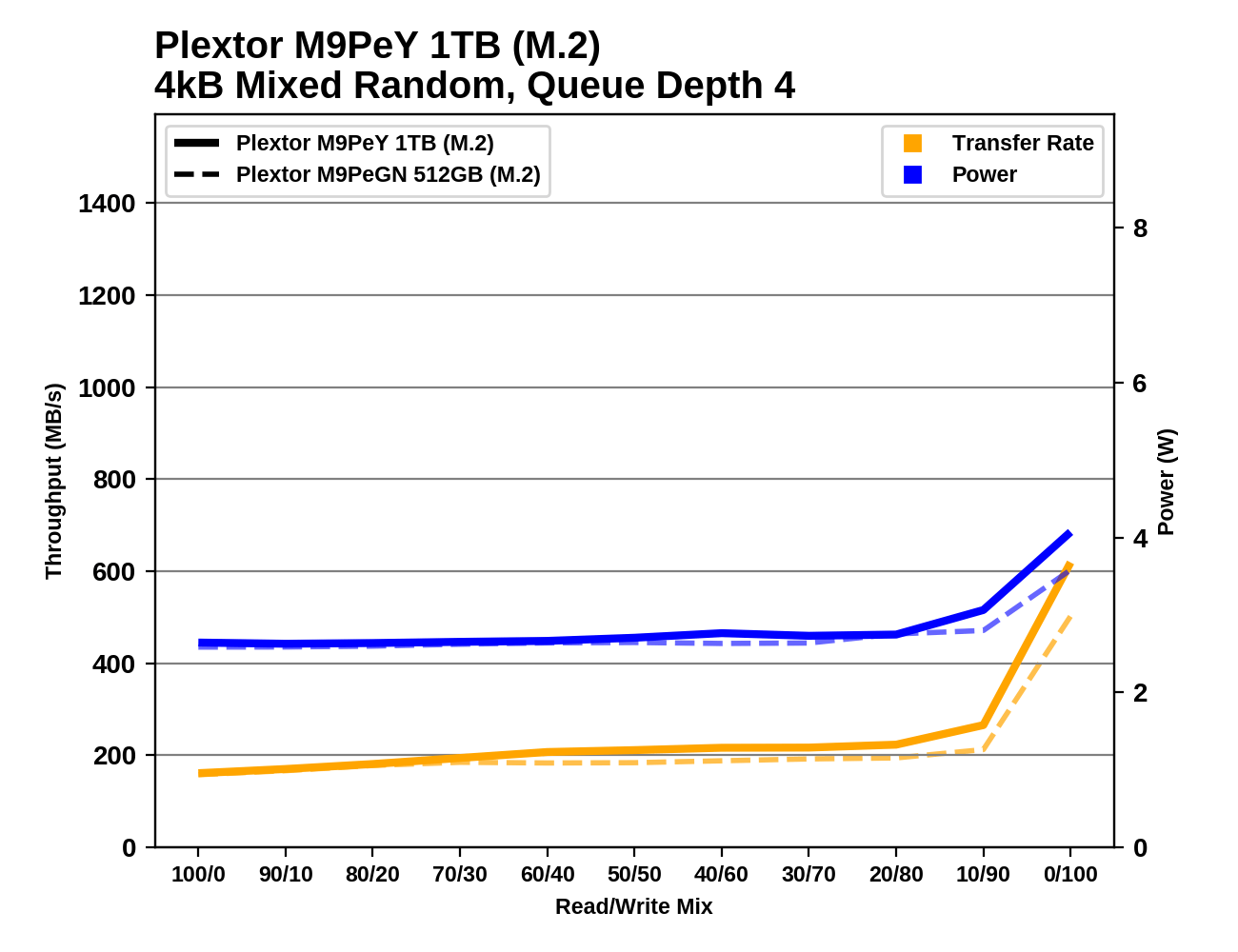The Plextor M9Pe NVMe SSD Review: Teaching An Old Chip New Tricks
by Billy Tallis on May 24, 2018 1:00 PM ESTMixed Random Performance
Our test of mixed random reads and writes covers mixes varying from pure reads to pure writes at 10% increments. Each mix is tested for up to 1 minute or 32GB of data transferred. The test is conducted with a queue depth of 4, and is limited to a 64GB span of the drive. In between each mix, the drive is given idle time of up to one minute so that the overall duty cycle is 50%.

The performance of the Plextor M9Pe on the mixed random I/O test is better than the SATA drive and the low-end NVMe drive, but is otherwise disappointing and not competitive with the other high-end SSDs or even the preceding M8Pe.
 |
|||||||||
| Power Efficiency in MB/s/W | Average Power in W | ||||||||
Power efficiency from the M9Pe on the mixed random I/O test is poor, but similar to the earlier Plextor drives. The drives with newer controllers not only perform better, but most also require much less power.
 |
|||||||||
The two capacities of the Plextor M9Pe show very similar performance scaling across the random I/O test, with very slow performance growth as the proportion of writes increases, until near the end of the test when there are enough writes to perform effective caching and coalescing. Most drives show much more substantial performance growth during the first 80% of the test.
Mixed Sequential Performance
Our test of mixed sequential reads and writes differs from the mixed random I/O test by performing 128kB sequential accesses rather than 4kB accesses at random locations, and the sequential test is conducted at queue depth 1. The range of mixes tested is the same, and the timing and limits on data transfers are also the same as above.

The mixed sequential I/O test again puts the M9Pe in the situation of being the slowest drive that's trying to be high-end. It does outperform the SATA drive and the MyDigitalSSD SBX, but drives like the WD Black and the Samsung NVMe SSDs are far faster.
 |
|||||||||
| Power Efficiency in MB/s/W | Average Power in W | ||||||||
Power efficiency from the M9Pe on the mixed sequential I/O test is actually worse than either of its predecessors, and worse than the Crucial MX500 SATA drive. The Intel SSD 760p and MyDigitalSSD SBX are slightly worse than the M9Pe, and the WD Black has more than 2.5 times the performance per Watt of the M9Pe.
 |
|||||||||
Neither capacity of the M9Pe does well during the more read-heavy half of the test, and only the 1TB model gets a substantial boost at the end of the test where the write caches are most effective.










15 Comments
View All Comments
Drazick - Friday, May 25, 2018 - link
I can see why you model Windows compatibility as a moving target.But in that case I think I read somewhere it was a known issue of the drives.
Would you approach Microsoft and find out?
It would be only fair before making assumptions.
DigitalFreak - Thursday, May 24, 2018 - link
I wish HP would hurry up with the 2TB version of the HP EX920.shabby - Thursday, May 24, 2018 - link
The ADATA XPG SX8200 uses the same controller but with more provisioning, a bit less space though, but it gives it a bit of a boost compared to the ex920. Review is on tomshardware for both.peevee - Wednesday, May 30, 2018 - link
Why does not AT review EX920? Beats overpriced Samsungs they are pushing all the time?asava - Thursday, June 21, 2018 - link
Hello,Any chance you could provide the identify namespace information for this drive? Under linux that would be by "nvme id-ns /dev/nvme0n1".
Thanks!